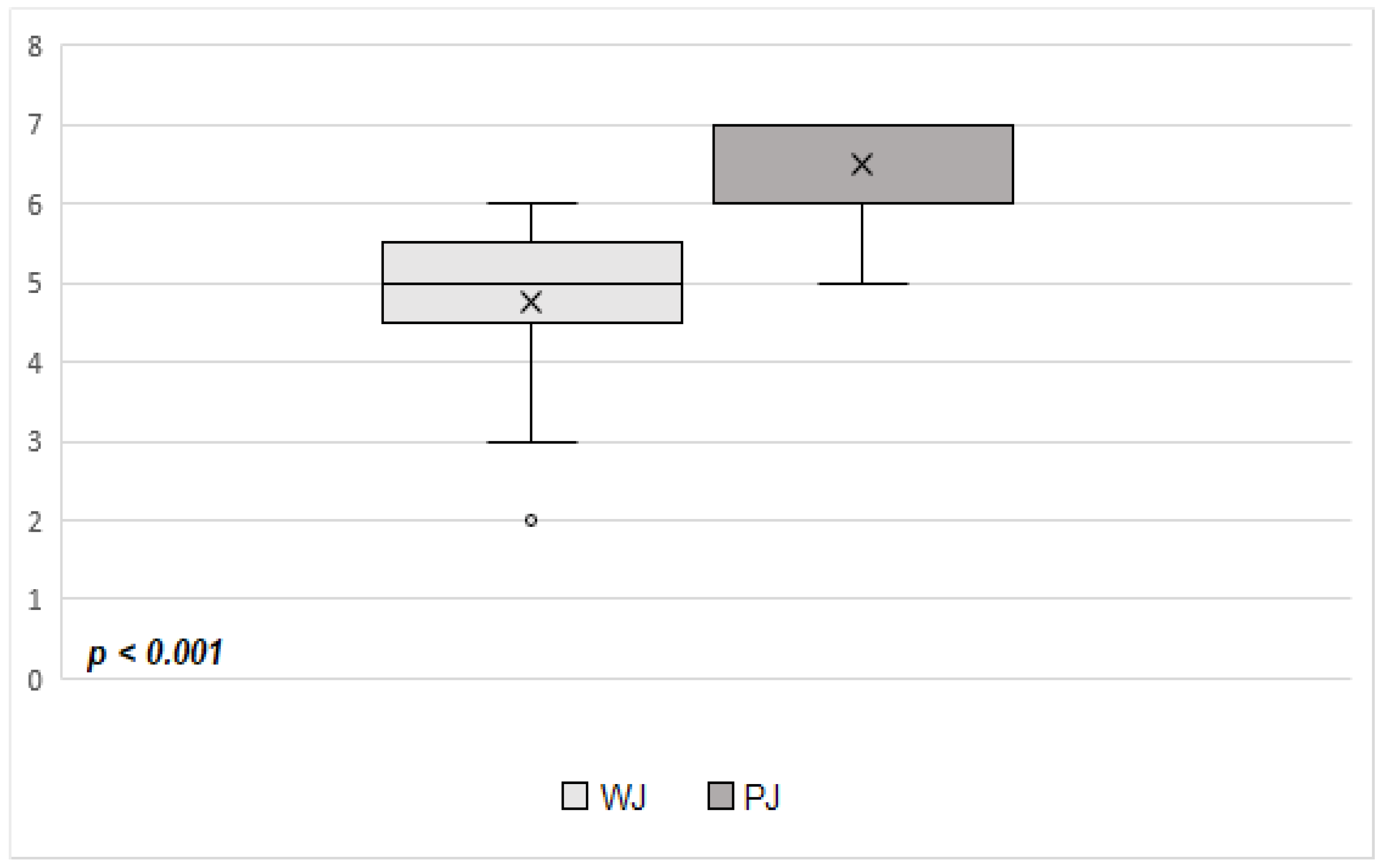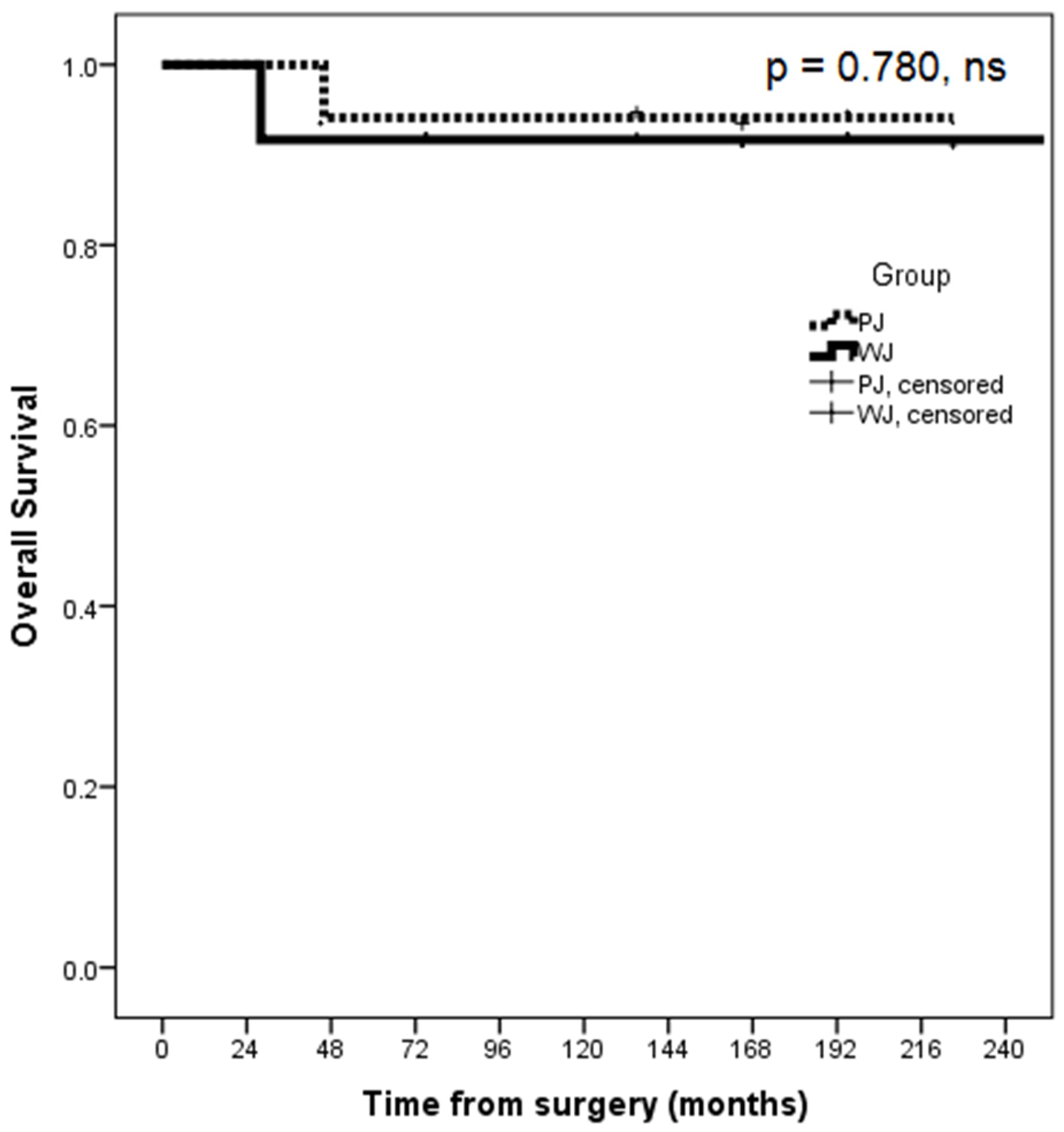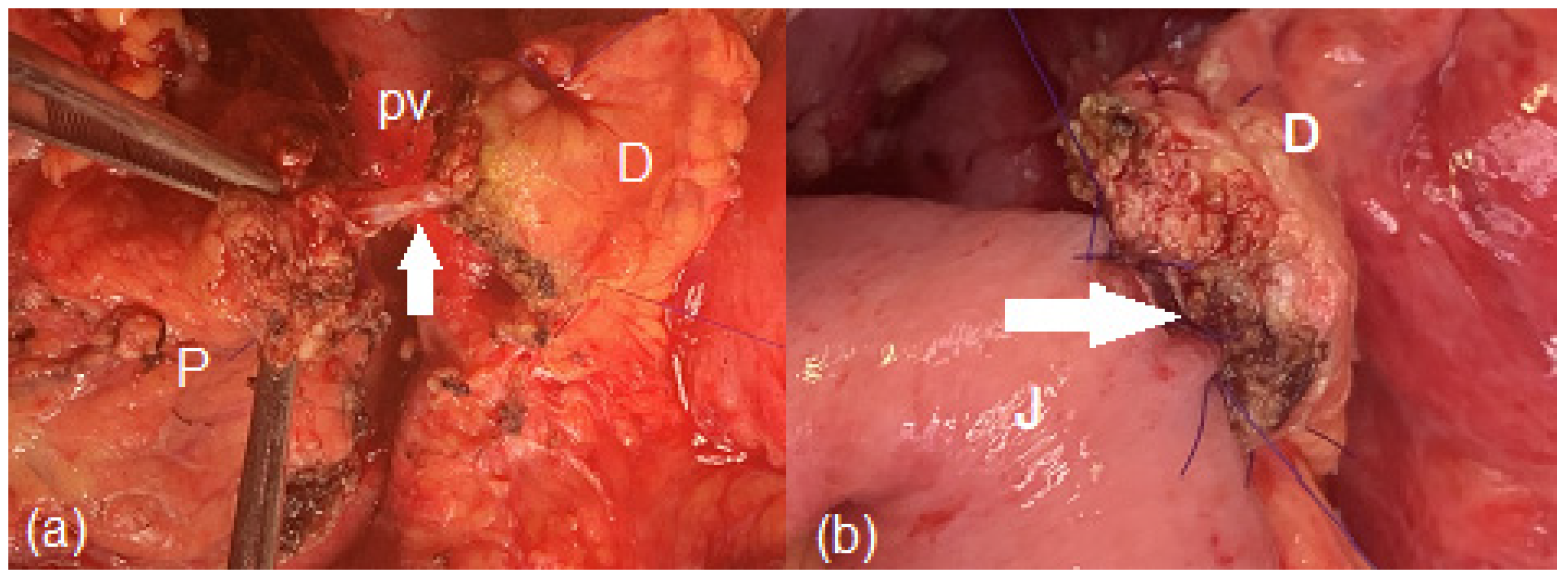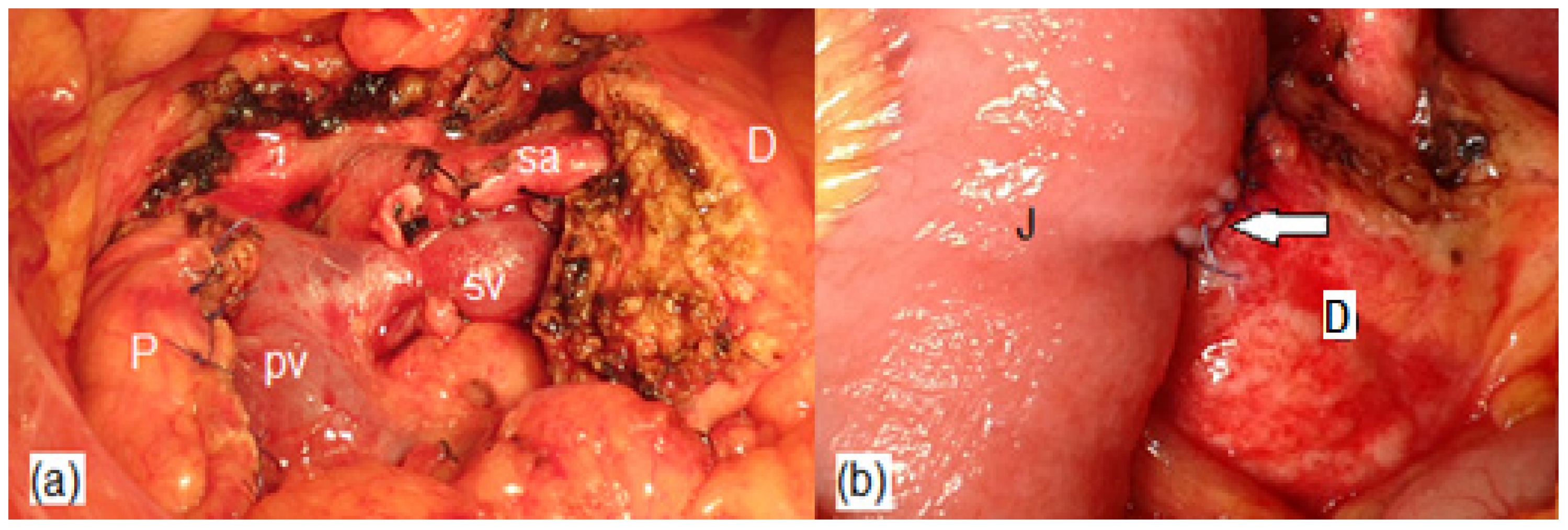Outcomes of Duct-to-Mucosa vs. Invagination Pancreatojejunostomy: Toward a Personalized Approach for Distal Pancreatic Stump Anastomosis in Central Pancreatectomy?
Abstract
1. Introduction
2. Materials and Methods
2.1. Patients and Surgical Technique
2.2. Definition of Outcomes
2.3. Statistics
3. Results
3.1. Demographics and Preoperative Parameters
3.2. Intraoperative Data
3.3. Early Postoperative Outcomes
3.4. Late Postoperative Outcomes
4. Discussion
5. Conclusions
Author Contributions
Funding
Institutional Review Board Statement
Informed Consent Statement
Data Availability Statement
Conflicts of Interest
References
- Crippa, S.; Bassi, C.; Warshaw, A.L.; Falconi, M.; Partelli, S.; Thayer, S.P.; Pederzoli, P.; Castillo, C.F. Middle Pancreatectomy: Indications, Short- and Long-Term Operative Outcomes. Ann. Surg. 2007, 246, 69–76. [Google Scholar] [CrossRef] [PubMed]
- Reber, H.A. Middle Pancreatectomy: Why I Rarely Do It. J. Gastrointest. Surg. 2007, 11, 730–732. [Google Scholar] [CrossRef] [PubMed]
- Del Chiaro, M. Are There Really Indications for Central Pancreatectomy? JAMA Surg. 2014, 149, 364. [Google Scholar] [CrossRef]
- Iacono, C.; Bortolasi, L.; Facci, E.; Nifosì, F.; Pachera, S.; Ruzzenente, A.; Guglielmi, A. The Dagradi-Serio-Iacono Operation Central Pancreatectomy. J. Gastrointest. Surg. 2007, 11, 364–376. [Google Scholar] [CrossRef] [PubMed]
- Xiao, W.; Zhu, J.; Peng, L.; Hong, L.; Sun, G.; Li, Y. The Role of Central Pancreatectomy in Pancreatic Surgery: A Systematic Review and Meta-Analysis. HPB 2018, 20, 896–904. [Google Scholar] [CrossRef]
- Li, Y.; Li, Y. Central versus Distal Pancreatectomy for Benign or Low-Grade Malignant Lesions in the Pancreatic Neck and Proximal Body. Am. Surg. 2019, 85, 1239–1245. [Google Scholar] [CrossRef]
- Dragomir, M.P.; Sabo, A.A.; Petrescu, G.E.D.; Li, Y.; Dumitrascu, T. Central Pancreatectomy: A Comprehensive, up-to-Date Meta-Analysis. Langenbecks Arch. Surg. 2019, 404, 945–958. [Google Scholar] [CrossRef]
- Klotz, R.; Schilling, C.; Kuner, C.; Hinz, U.; Klaiber, U.; Holze, M.; Tjaden, C.; Loos, M.; Büchler, M.W.; Hackert, T. Central Pancreatectomy Prevents Postoperative Diabetes. J. Hepato-Biliary-Pancreat. Sci. 2022, jhbp.1296. [Google Scholar] [CrossRef]
- Regmi, P.; Yang, Q.; Hu, H.-J.; Liu, F.; Karn, H.R.; Ma, W.-J.; Ran, C.-D.; Li, F.-Y. Overall Postoperative Morbidity and Pancreatic Fistula Are Relatively Higher after Central Pancreatectomy than Distal Pancreatic Resection: A Systematic Review and Meta-Analysis. BioMed Res. Int. 2020, 2020, 7038907. [Google Scholar] [CrossRef]
- Goudard, Y.; Gaujoux, S.; Dokmak, S.; Cros, J.; Couvelard, A.; Palazzo, M.; Ronot, M.; Vullierme, M.-P.; Ruszniewski, P.; Belghiti, J.; et al. Reappraisal of Central Pancreatectomy: A 12-Year Single-Center Experience. JAMA Surg. 2014, 149, 356. [Google Scholar] [CrossRef]
- Ouyang, L.; Liu, R.; Ren, Y.; Nie, G.; He, T.; Li, G.; Zhou, Y.; Huang, Z.; Zhang, Y.; Hu, X.; et al. Nomogram Predicts CR-POPF in Open Central Pancreatectomy Patients with Benign or Low-Grade Malignant Pancreatic Neoplasms. Front. Oncol. 2022, 12, 1030080. [Google Scholar] [CrossRef]
- Paiella, S.; De Pastena, M.; Faustini, F.; Landoni, L.; Pollini, T.; Bonamini, D.; Giuliani, T.; Bassi, C.; Esposito, A.; Tuveri, M.; et al. Central Pancreatectomy for Benign or Low-Grade Malignant Pancreatic Lesions—A Single-Center Retrospective Analysis of 116 Cases. Eur. J. Surg. Oncol. 2019, 45, 788–792. [Google Scholar] [CrossRef]
- Beger, H.G.; Poch, B.; Vasilescu, C. Benign Cystic Neoplasm and Endocrine Tumours of the Pancreas—When and How to Operate—An Overview. Int. J. Surg. 2014, 12, 606–614. [Google Scholar] [CrossRef]
- Kamarajah, S.K.; Bundred, J.R.; Lin, A.; Halle-Smith, J.; Pande, R.; Sutcliffe, R.; Harrison, E.M.; Roberts, K.J.; PARANOIA Study Group. Systematic Review and Meta-Analysis of Factors Associated with Post-Operative Pancreatic Fistula Following Pancreatoduodenectomy. ANZ J. Surg. 2021, 91, 810–821. [Google Scholar] [CrossRef] [PubMed]
- Zhang, B.; Yuan, Q.; Li, S.; Xu, Z.; Chen, X.; Li, L.; Shang, D. Risk Factors of Clinically Relevant Postoperative Pancreatic Fistula after Pancreaticoduodenectomy: A Systematic Review and Meta-Analysis. Medicine 2022, 101, e29757. [Google Scholar] [CrossRef]
- Müller, M.W.; Friess, H.; Kleeff, J.; Hinz, U.; Wente, M.N.; Paramythiotis, D.; Berberat, P.O.; Ceyhan, G.O.; Büchler, M.W. Middle Segmental Pancreatic Resection: An Option to Treat Benign Pancreatic Body Lesions. Ann. Surg. 2006, 244, 909–920. [Google Scholar] [CrossRef]
- Adham, M.; Giunippero, A.; Hervieu, V.; Courbière, M.; Partensky, C. Central Pancreatectomy: Single-Center Experience of 50 Cases. Arch. Surg. Chic. Ill 1960 2008, 143, 175–180; discussion 180–181. [Google Scholar] [CrossRef] [PubMed]
- DiNorcia, J.; Ahmed, L.; Lee, M.K.; Reavey, P.L.; Yakaitis, E.A.; Lee, J.A.; Schrope, B.A.; Chabot, J.A.; Allendorf, J.D. Better Preservation of Endocrine Function after Central versus Distal Pancreatectomy for Mid-Gland Lesions. Surgery 2010, 148, 1247–1256. [Google Scholar] [CrossRef]
- Machado, M.A.C.; Surjan, R.C.; Epstein, M.G.; Makdissi, F.F. Laparoscopic Central Pancreatectomy: A Review of 51 Cases. Surg. Laparosc. Endosc. Percutan. Tech. 2013, 23, 486–490. [Google Scholar] [CrossRef]
- Chen, S.; Zhan, Q.; Jin, J.; Wu, Z.; Shi, Y.; Cheng, D.; Chen, H.; Deng, X.; Shen, B.; Peng, C.; et al. Robot-Assisted Laparoscopic versus Open Middle Pancreatectomy: Short-Term Results of a Randomized Controlled Trial. Surg. Endosc. 2017, 31, 962–971. [Google Scholar] [CrossRef] [PubMed]
- Shrikhande, S.V.; Sivasanker, M.; Vollmer, C.M.; Friess, H.; Besselink, M.G.; Fingerhut, A.; Yeo, C.J.; Fernandez-delCastillo, C.; Dervenis, C.; Halloran, C.; et al. Pancreatic Anastomosis after Pancreatoduodenectomy: A Position Statement by the International Study Group of Pancreatic Surgery (ISGPS). Surgery 2017, 161, 1221–1234. [Google Scholar] [CrossRef]
- Lyu, Y.; Li, T.; Wang, B.; Cheng, Y.; Zhao, S. Selection of Pancreaticojejunostomy Technique after Pancreaticoduodenectomy: Duct-to-Mucosa Anastomosis Is Not Better than Invagination Anastomosis: A Meta-Analysis. Medicine 2018, 97, e12621. [Google Scholar] [CrossRef] [PubMed]
- Wang, W.; Zhang, Z.; Gu, C.; Liu, Q.; Liang, Z.; He, W.; Chen, J.; Lai, J. The Optimal Choice for Pancreatic Anastomosis after Pancreaticoduodenectomy: A Network Meta-Analysis of Randomized Control Trials. Int. J. Surg. 2018, 57, 111–116. [Google Scholar] [CrossRef] [PubMed]
- Xiang, Y.; Wu, J.; Lin, C.; Yang, Y.; Zhang, D.; Xie, Y.; Yao, X.; Zhang, X. Pancreatic Reconstruction Techniques after Pancreaticoduodenectomy: A Review of the Literature. Expert Rev. Gastroenterol. Hepatol. 2019, 13, 797–806. [Google Scholar] [CrossRef]
- Kone, L.B.; Maker, V.K.; Banulescu, M.; Maker, A.V. A Propensity Score Analysis of over 12,000 Pancreaticojejunal Anastomoses after Pancreaticoduodenectomy: Does Technique Impact the Clinically Relevant Fistula Rate? HPB 2020, 22, 1394–1401. [Google Scholar] [CrossRef]
- Ratnayake, C.B.B.; Wells, C.I.; Kamarajah, S.K.; Loveday, B.; Sen, G.; French, J.J.; White, S.; Pandanaboyana, S. Critical Appraisal of the Techniques of Pancreatic Anastomosis Following Pancreaticoduodenectomy: A Network Meta-Analysis. Int. J. Surg. 2020, 73, 72–77. [Google Scholar] [CrossRef] [PubMed]
- Cao, Z.; Luo, W.; Qiu, J.; Liu, Y.; Zheng, L.; Zhang, T. Is Invagination Anastomosis More Effective in Reducing Clinically Relevant Pancreatic Fistula for Soft Pancreas After Pancreaticoduodenectomy Under Novel Fistula Criteria: A Systematic Review and Meta-Analysis. Front. Oncol. 2020, 10, 1637. [Google Scholar] [CrossRef]
- Zhang, S.; Lan, Z.; Zhang, J.; Chen, Y.; Xu, Q.; Jiang, Q.; Zhao, Y.; Wang, C.; Bi, X.; Huang, X. Duct-to-Mucosa versus Invagination Pancreaticojejunostomy after Pancreaticoduodenectomy: A Meta-Analysis. Oncotarget 2017, 8, 46449–46460. [Google Scholar] [CrossRef]
- El Nakeeb, A.; El Hemaly, M.; Askr, W.; Abd Ellatif, M.; Hamed, H.; Elghawalby, A.; Attia, M.; Abdallah, T.; Abd ElWahab, M. Comparative Study between Duct to Mucosa and Invagination Pancreaticojejunostomy after Pancreaticoduodenectomy: A Prospective Randomized Study. Int. J. Surg. 2015, 16, 1–6. [Google Scholar] [CrossRef] [PubMed]
- Li, Y.; Hua, R. The Optimal Choice for Pancreatic Anastomosis after Pancreaticoduodenectomy. Minerva Surg. 2022, 77, 65–71. [Google Scholar] [CrossRef]
- Hai, H.; Li, Z.; Zhang, Z.; Cheng, Y.; Liu, Z.; Gong, J.; Deng, Y. Duct-to-Mucosa versus Other Types of Pancreaticojejunostomy for the Prevention of Postoperative Pancreatic Fistula Following Pancreaticoduodenectomy. Cochrane Database Syst. Rev. 2022, 2022, 1465–1858. [Google Scholar] [CrossRef]
- Petrova, E.; Suurmeijer, J.A.; Mackay, T.M.; Bolm, L.; Lapshyn, H.; Honselmann, K.C.; van Santvoort, H.C.; Koerkamp, B.G.; Wellner, U.F.; Keck, T.; et al. Outcome of Pancreatic Anastomoses during Pancreatoduodenectomy in Two National Audits. Surgery 2021, 170, 1799–1806. [Google Scholar] [CrossRef] [PubMed]
- Venara, A.; de Franco, V.; Mucci, S.; Frampas, E.; Lermite, E.; Regenet, N.; Hamy, A. Central Pancreatectomy: Comparison of Results According to the Type of Anastomosis. J. Visc. Surg. 2012, 149, e153–e158. [Google Scholar] [CrossRef]
- Borel, F.; Ouaissi, M.; Merdrignac, A.; Venara, A.; De Franco, V.; Sulpice, L.; Hamy, A.; Regenet, N. Pancreatico-Jejunostomy Decreases Post-Operative Pancreatic Fistula Incidence and Severity after Central Pancreatectomy: Pancreatic Anastomosis in Central Pancreatectomy. ANZ J. Surg. 2018, 88, 77–81. [Google Scholar] [CrossRef]
- Wang, Z.-Z.; Zhao, G.-D.; Zhao, Z.-M.; Hu, M.-G.; Tan, X.-L.; Zhang, X.; Gao, Y.-X.; Liu, R. A Comparative Study of End-to-End Pancreatic Anastomosis versus Pancreaticojejunostomy after Robotic Central Pancreatectomy. Updates Surg. 2021, 73, 967–975. [Google Scholar] [CrossRef] [PubMed]
- Dumitrascu, T.; Stanciulea, O.; Herlea, V.; Tomulescu, V.; Ionescu, M. Central Pancreatectomy for Pancreatoblastoma in a 16-Year-Old Girl. J. Pediatr. Surg. 2011, 46, e17–e21. [Google Scholar] [CrossRef]
- Popescu, I. Central pancreatectomy. In Atlas of Advanced Operative Surgery; Khatri, V.P., Ed.; Elsevier: Philadelphia, PA, USA, 2013; ISBN 978-1-4160-4109-2. [Google Scholar]
- Dindo, D.; Demartines, N.; Clavien, P.-A. Classification of Surgical Complications: A New Proposal with Evaluation in a Cohort of 6336 Patients and Results of a Survey. Ann. Surg. 2004, 240, 205–213. [Google Scholar] [CrossRef] [PubMed]
- Bassi, C.; Dervenis, C.; Butturini, G.; Fingerhut, A.; Yeo, C.; Izbicki, J.; Neoptolemos, J.; Sarr, M.; Traverso, W.; Buchler, M. Postoperative Pancreatic Fistula: An International Study Group (ISGPF) Definition. Surgery 2005, 138, 8–13. [Google Scholar] [CrossRef] [PubMed]
- Wente, M.N.; Veit, J.A.; Bassi, C.; Dervenis, C.; Fingerhut, A.; Gouma, D.J.; Izbicki, J.R.; Neoptolemos, J.P.; Padbury, R.T.; Sarr, M.G.; et al. Postpancreatectomy Hemorrhage (PPH)—An International Study Group of Pancreatic Surgery (ISGPS) Definition. Surgery 2007, 142, 20–25. [Google Scholar] [CrossRef] [PubMed]
- Wente, M.N.; Bassi, C.; Dervenis, C.; Fingerhut, A.; Gouma, D.J.; Izbicki, J.R.; Neoptolemos, J.P.; Padbury, R.T.; Sarr, M.G.; Traverso, L.W.; et al. Delayed Gastric Emptying (DGE) after Pancreatic Surgery: A Suggested Definition by the International Study Group of Pancreatic Surgery (ISGPS). Surgery 2007, 142, 761–768. [Google Scholar] [CrossRef]
- Callery, M.P.; Pratt, W.B.; Kent, T.S.; Chaikof, E.L.; Vollmer, C.M. A Prospectively Validated Clinical Risk Score Accurately Predicts Pancreatic Fistula after Pancreatoduodenectomy. J. Am. Coll. Surg. 2013, 216, 1–14. [Google Scholar] [CrossRef] [PubMed]
- Slankamenac, K.; Graf, R.; Barkun, J.; Puhan, M.A.; Clavien, P.-A. The Comprehensive Complication Index: A Novel Continuous Scale to Measure Surgical Morbidity. Ann. Surg. 2013, 258, 1–7. [Google Scholar] [CrossRef] [PubMed]
- Singh, A.N.; Pal, S.; Mangla, V.; Kilambi, R.; George, J.; Dash, N.R.; Chattopadhyay, T.K.; Sahni, P. Pancreaticojejunostomy: Does the Technique Matter? A Randomized Trial. J. Surg. Oncol. 2018, 117, 389–396. [Google Scholar] [CrossRef] [PubMed]
- Senda, Y.; Shimizu, Y.; Natsume, S.; Ito, S.; Komori, K.; Abe, T.; Matsuo, K.; Sano, T. Randomized Clinical Trial of Duct-to-Mucosa versus Invagination Pancreaticojejunostomy after Pancreatoduodenectomy. Br. J. Surg. 2017, 105, 48–57. [Google Scholar] [CrossRef] [PubMed]
- Bai, X.; Zhang, Q.; Gao, S.; Lou, J.; Li, G.; Zhang, Y.; Ma, T.; Zhang, Y.; Xu, Y.; Liang, T. Duct-to-Mucosa vs. Invagination for Pancreaticojejunostomy after Pancreaticoduodenectomy: A Prospective, Randomized Controlled Trial from a Single Surgeon. J. Am. Coll. Surg. 2016, 222, 10–18. [Google Scholar] [CrossRef] [PubMed]
- Bassi, C.; Falconi, M.; Molinari, E.; Mantovani, W.; Butturini, G.; Gumbs, A.A.; Salvia, R.; Pederzoli, P. Duct-to-Mucosa versus End-to-Side Pancreaticojejunostomy Reconstruction after Pancreaticoduodenectomy: Results of a Prospective Randomized Trial. Surgery 2003, 134, 766–771. [Google Scholar] [CrossRef]
- Langrehr, J.M.; Bahra, M.; Jacob, D.; Glanemann, M.; Neuhaus, P. Prospective Randomized Comparison between a New Mattress Technique and Cattell (Duct-to-Mucosa) Pancreaticojejunostomy for Pancreatic Resection. World J. Surg. 2005, 29, 1111–1119. [Google Scholar] [CrossRef] [PubMed]
- Berger, A.C.; Howard, T.J.; Kennedy, E.P.; Sauter, P.K.; Bower-Cherry, M.; Dutkevitch, S.; Hyslop, T.; Schmidt, M.C.; Rosato, E.L.; Lavu, H.; et al. Does Type of Pancreaticojejunostomy after Pancreaticoduodenectomy Decrease Rate of Pancreatic Fistula? A Randomized, Prospective, Dual-Institution Trial. J. Am. Coll. Surg. 2009, 208, 738–747. [Google Scholar] [CrossRef]
- Rivas, L.; Zettervall, S.L.; Ju, T.; Olafson, S.; Holzmacher, J.; Lin, P.P.; Vaziri, K. The Effect of Pancreaticojejunostomy Technique on Fistula Formation Following Pancreaticoduodenectomy in the Soft Pancreas. J. Gastrointest. Surg. 2019, 23, 2211–2215. [Google Scholar] [CrossRef]
- Dumitrascu, T.; Barbu, S.T.; Purnichescu-Purtan, R.; Ionescu, M.; Popescu, I. Risk Factors for Surgical Complications after Central Pancreatectomy. Hepatogastroenterology 2012, 59, 592–598. [Google Scholar] [CrossRef]
- Wolk, S.; Distler, M.; Kersting, S.; Weitz, J.; Saeger, H.-D.; Grützmann, R. Evaluation of Central Pancreatectomy and Pancreatic Enucleation as Pancreatic Resections—A Comparison. Int. J. Surg. 2015, 22, 118–124. [Google Scholar] [CrossRef] [PubMed]
- Qin, H.; Luo, L.; Zhu, Z.; Huang, J. Pancreaticogastrostomy Has Advantages over Pancreaticojejunostomy on Pancreatic Fistula after Pancreaticoduodenectomy. A Meta-Analysis of Randomized Controlled Trials. Int. J. Surg. 2016, 36, 18–24. [Google Scholar] [CrossRef] [PubMed]
- Ricci, C.; Casadei, R.; Taffurelli, G.; Pacilio, C.A.; Beltrami, D.; Minni, F. Is Pancreaticogastrostomy Safer than Pancreaticojejunostomy after Pancreaticoduodenectomy? A Meta-Regression Analysis of Randomized Clinical Trials. Pancreatology 2017, 17, 805–813. [Google Scholar] [CrossRef] [PubMed]
- Dumitraşcu, T.; Braşoveanu, V.; Dima, S.; Popescu, I. The Optimal Management of Distal Pancreatic Stump After Pancreatico-Duodenectomy: Different Indications for Gastric and Jejunal Anastomoses. Chir. Buchar. Rom. 1990 2022, 117, 437–446. [Google Scholar] [CrossRef]




| Parameter | WJ Group (12 Patients) | PJ Group (17 Patients) | p Value |
|---|---|---|---|
| Age, years | 51 (14–71) | 36 (16–66) | 0.412, ns |
| Female sex | 7 patients (58.3%) | 12 patients (70.6%) | 0.694, ns |
| Body mass index, kg/m2 | 29.5 (18.5–42) | 22 (18.5–36.5) | 0.126, ns |
| Smoking | 5 patients (41.7%) | 4 patients (23.5%) | 0.422, ns |
| Alcohol abuse | 2 patients (16.7%) | 1 patient (5.9%) | 0.553, ns |
| Cardiovascular comorbidities | 6 patients (50%) | 3 patients (17.6%) | 0.105, ns |
| Diabetes mellitus | 2 patients (16.7%) | 2 patients (11.8%) | 1, ns |
| Chronic pancreatitis | 1 patient (8.3%) | 1 patient (5.9%) | 1, ns |
| ASA score ≥3 | 4 patients (33.3%) | 3 patients (17.6%) | 0.402, ns |
| Karnofsky score, points | 90 (80–100) | 90 (80–100) | 1, ns |
| Parameter | WJ Group (12 Patients) | PJ Group (17 Patients) | p Value |
|---|---|---|---|
| Associated procedures | 2 patients (16.7%) | 2 patients (11.8%) | 1, ns |
| Soft pancreas texture | 10 patients (83.3%) | 16 patients (94.1%) | 0.553, ns |
| Wirsung duct diameter, mm | 3 (2–3) | 1 (1–6) | <0.0003 |
| Operative time, min | 195 (120–480) | 140 (100–205) | 0.012 |
| Estimated blood loss, ml | 125 (50–500) | 50 (50–300) | 0.138, ns |
| Malignant pathology | 2 patients (16.7%) | 2 patients (11.8%) | 1, ns |
| Neuroendocrine pathology | 2 patients (16.7%) | 5 patients (29.4%) | 0.205, ns |
| Tumor diameter, cm | 3 (2–14) | 2.7 (1.1–6) | 0.347, ns |
| Pancreatic Fistula Risk Score [42], points | 5 (3–6) | 7 (2–7) | <0.001 |
| High-pancreatic fistula risk group [42] | 0 patients (0%) | 9 patients (52.9%) | 0.003 |
| Parameter | WJ Group (12 Patients) | PJ Group (17 Patients) | p Value |
|---|---|---|---|
| Overall complications | 8 patients (66.7%) | 10 patients (58.8%) | 0.716, ns |
| Severe complications (i.e., grade 3–4 Dindo) | 4 patients (33.3%) | 3 patients (17.6%) | 0.402, ns |
| 90-day mortality | 0 patients (0%) | 0 patients (0%) | 1, ns |
| Clinically relevant POPF (i.e., grade B–C) | 5 patients (41.7%) | 7 patients (41.2%) | 1, ns |
| Clinically relevant DGE (i.e., grade B–C) | 2 patients (16.7%) | 3 patients (17.6%) | 1, ns |
| Clinically relevant PPH (i.e., grade B–C) | 2 patients (16.7%) | 2 patients (11.8%) | 1, ns |
| Postoperative blood transfusions for complications | 2 patients (16.7%) | 3 patients (17.6%) | 1, ns |
| Relaparotomy for complications | 4 patients (33.3%) | 3 patients (17.6%) | 0.402, ns |
| Postoperative hospital stays, days | 20 (6–45) | 12 (7–32) | 0.170, ns |
| Postoperative abdominal drainage time, days | 10 (5–44) | 5 (5–28) | 0.373, ns |
| Comprehensive Complication Index [43] | 8.7 (0–56.1) | 8.7 (0–47.7) | 0.535, ns |
| Parameter | WJ Group (12 Patients) | PJ Group (17 Patients) | p Value |
|---|---|---|---|
| Follow-up time, months | 203 (28–251) | 157 (46–225) | 0.019 |
| Overall survival time *, months | 232 ± 18 | 215 ± 10 | 0.780, ns |
| New-onset or worsening diabetes mellitus | 2 patients (16.7%) | 2 patients (11.8%) | 1, ns |
| Clinically relevant postoperative exocrine pancreatic insufficiency | 0 patients (0%) | 0 patients (0%) | 1, ns |
Disclaimer/Publisher’s Note: The statements, opinions and data contained in all publications are solely those of the individual author(s) and contributor(s) and not of MDPI and/or the editor(s). MDPI and/or the editor(s) disclaim responsibility for any injury to people or property resulting from any ideas, methods, instructions or products referred to in the content. |
© 2023 by the authors. Licensee MDPI, Basel, Switzerland. This article is an open access article distributed under the terms and conditions of the Creative Commons Attribution (CC BY) license (https://creativecommons.org/licenses/by/4.0/).
Share and Cite
Dumitrascu, T.; Popescu, I. Outcomes of Duct-to-Mucosa vs. Invagination Pancreatojejunostomy: Toward a Personalized Approach for Distal Pancreatic Stump Anastomosis in Central Pancreatectomy? J. Pers. Med. 2023, 13, 858. https://doi.org/10.3390/jpm13050858
Dumitrascu T, Popescu I. Outcomes of Duct-to-Mucosa vs. Invagination Pancreatojejunostomy: Toward a Personalized Approach for Distal Pancreatic Stump Anastomosis in Central Pancreatectomy? Journal of Personalized Medicine. 2023; 13(5):858. https://doi.org/10.3390/jpm13050858
Chicago/Turabian StyleDumitrascu, Traian, and Irinel Popescu. 2023. "Outcomes of Duct-to-Mucosa vs. Invagination Pancreatojejunostomy: Toward a Personalized Approach for Distal Pancreatic Stump Anastomosis in Central Pancreatectomy?" Journal of Personalized Medicine 13, no. 5: 858. https://doi.org/10.3390/jpm13050858
APA StyleDumitrascu, T., & Popescu, I. (2023). Outcomes of Duct-to-Mucosa vs. Invagination Pancreatojejunostomy: Toward a Personalized Approach for Distal Pancreatic Stump Anastomosis in Central Pancreatectomy? Journal of Personalized Medicine, 13(5), 858. https://doi.org/10.3390/jpm13050858






